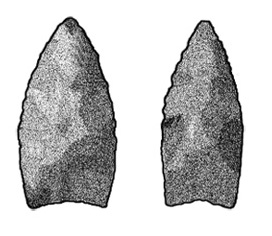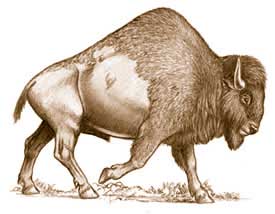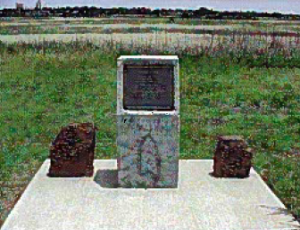Contrary to what some Texans think, Texas history actually goes back thousands of years before the Alamo. Humans have lived in the Southwest for over ten thousand years, although the exact date of their arrival is subject to intense debate among archaeologists.
While there are a vast number of topics I could (and will) write about from historical times, I’ve always been interested in prehistory. So from time to time, I’m going to be posting about topics involving the centuries before the coming of the Europeans. Don’t be surprised if these posts focus on the extinct megafauna from the Ice Age.
For this post, I want to look at the interaction between man and beast.

“Plainview point” by France3470 – Own work. Licensed under CC BY-SA 3.0 via Commons – https://commons.wikimedia.org/wiki/File:Plainview_point.jpg#/media/File:Plainview_point.jpg
In the mid-1940s, the remains of an ancient bison kill were found near the city of Plainview. Among the bones of approximately 100 bison antiquus were spearheads of the type now known as Plainview Points.
As shown in the figure on the left, the points consists of two convex sides and have a concave bases. Plainview points contain no fluting. This style of point is widespread on the South Plains.
The bison antiquus was the most common large herbivore in North America 10,000 years ago and a common food source for the paleopeoples on the continent at that time. Kills can be found all over the plains. Not only did the bison provide meat, but their hides were used for shelter and clothing, and the bones and horns made into tools.
Bison antiquus was larger than the modern bison. It reached up to 2.27 m (7.5 ft) tall, 4.6 m (15 ft) long, and a weight of 1,588 kg(3500 lb). That’s a lot of meat on the hoof.
Bison are herd animals and have a tendency to stampede. Indians who hunted the bison before Europeans reintroduced the horse had to hunt on foot. Those who lived near a ravine, canyon, or significant dropoff had an advantage in that if they could get the herd to stampede in the direction of the ravine, then even if the lead animals tried to stop, the momentum of the animals behind them would result in some of the bison plunging to their deaths.
Of course not all of the animals would have been killed immediately. That’s where the spear points come in. As any hunter can tell you, generally speaking the most dangerous animal is a wounded one. The hunters had to go down in the kill and dispatch the wounded.
Bison kills are an excellent way to learn about how the paleoindians interacted with their environment. It’s easy to think of bison kills as being common, but in reality they probably weren’t. Both skill and luck came into play when a bison hunt was successful. Bison, however, do migrate, so getting the bison to stampede over the cliff wasn’t always possible. The bison had to be in the right place at the right time. They weren’t something people could count on to provide food, clothing, and supplies.
Another interesting fact is that, unlike popular perceptions of primitive peoples only taking what they need, bison kills were wasteful. A successful bison kill would result in a lot of meat. Even with the methods paleoindians had to preserve the meat, archeaological evidence indicates that there was a great deal of waste. It wouldn’t take long for the meat to spoil in the hot Texas sun.
There has been some debate about the role prehistoric man played in the extinction of megafauna such as the mastodon and mammoth in North America. Bison kills are evidence that at least some of the large mammals were hunted en masse by paleoindians.



Pingback: Chasing Buffalo - Frontier Partisans